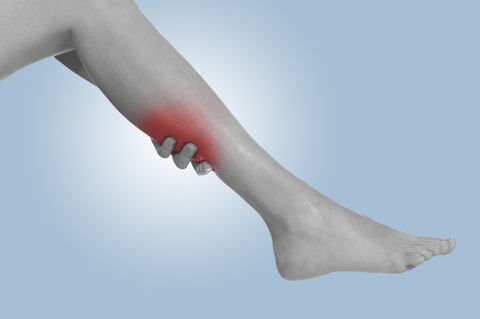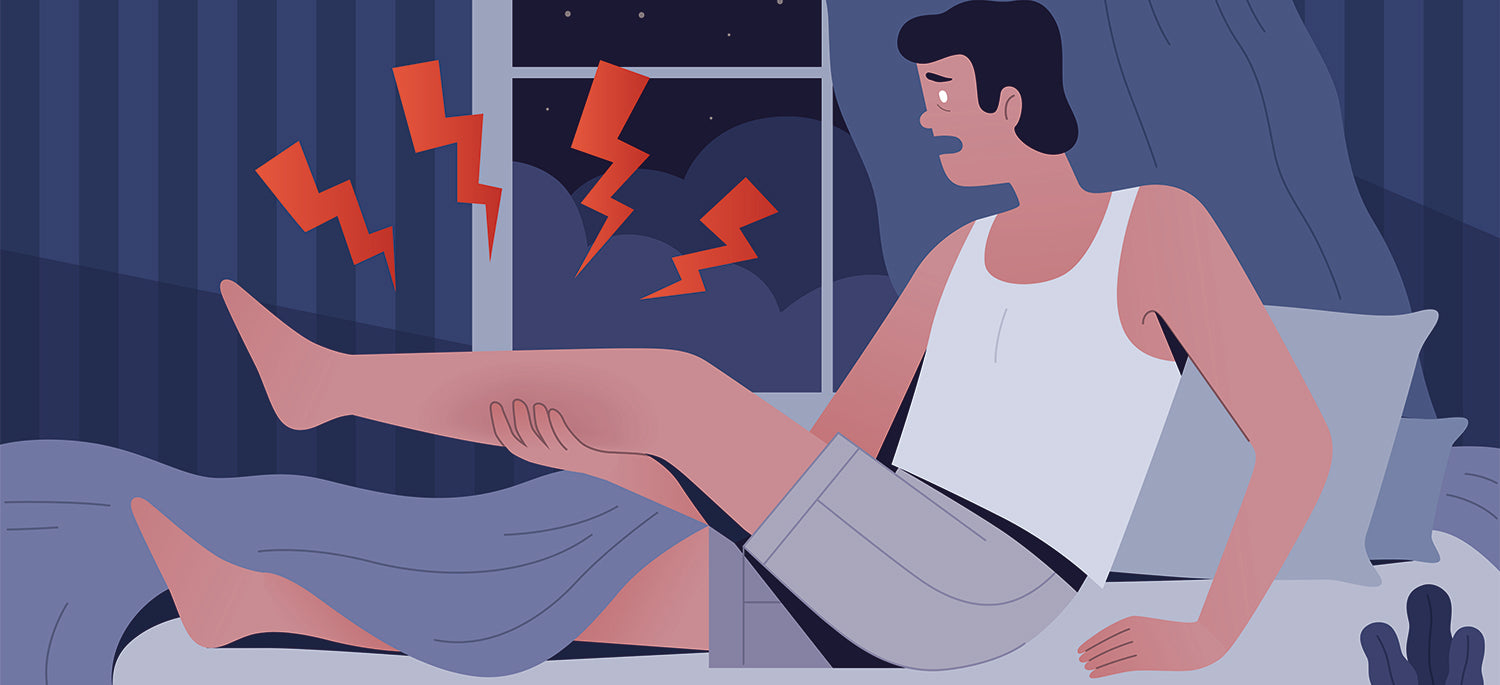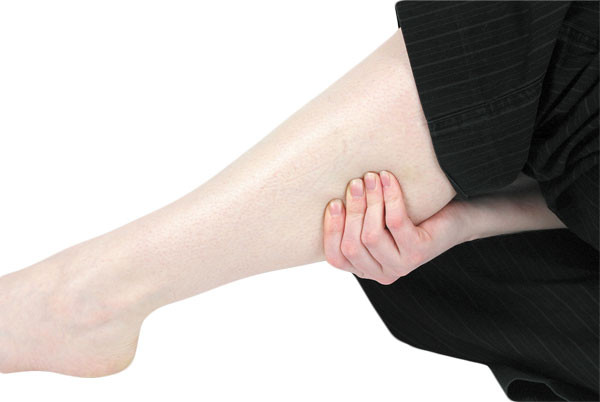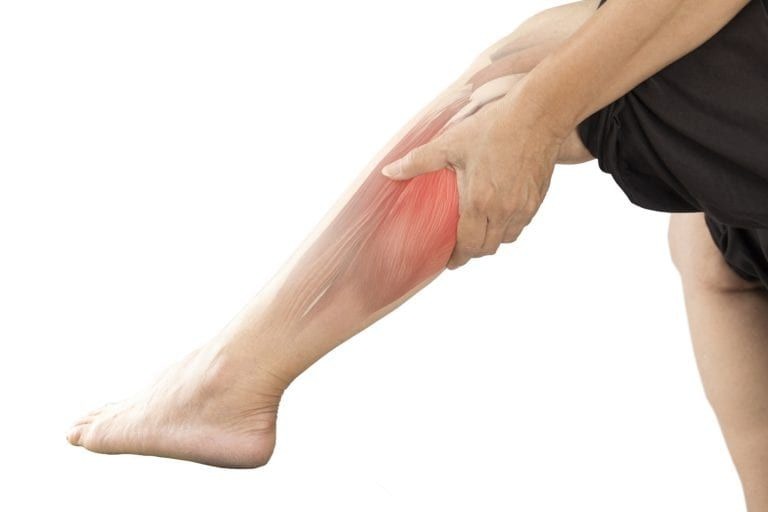Nighttime leg cramps are a common condition that affects people of all ages. These painful, involuntary muscle contractions, often occurring in the calf, thigh, or foot, can disrupt sleep and cause lingering soreness. Also known as nocturnal leg cramps, these episodes usually strike suddenly and can last anywhere from a few seconds to several minutes.
Although leg cramps at night are generally not harmful, they can negatively affect sleep quality and overall well-being. Understanding the potential causes, risk factors, and ways to manage these cramps can help reduce their frequency and intensity.

What Are Nighttime Leg Cramps?
Nighttime leg cramps refer to sudden, involuntary muscle contractions that typically occur during periods of rest, especially at night. Most people describe the sensation as a tightening or knotting of the muscle, accompanied by sharp pain. After the cramp passes, muscle tenderness may persist for several hours.
Unlike restless leg syndrome (RLS), which is a neurological condition causing an urge to move the legs, leg cramps involve intense muscular contractions and physical discomfort that are not relieved by movement until the cramp ends.

Common Causes of Leg Cramps at Night
Several factors may contribute to the development of nighttime leg cramps. These include:
1. Dehydration
Insufficient fluid intake throughout the day may lead to an imbalance in electrolytes such as sodium, potassium, and magnesium—minerals necessary for proper muscle function. Dehydration can cause muscles to become more prone to cramping, particularly during rest.
Source: Mayo Clinic – Muscle Cramp Causes
2. Electrolyte Imbalances
Low levels of essential minerals—especially calcium, potassium, and magnesium—can impair muscle contraction and relaxation. These imbalances are commonly seen in individuals with dietary deficiencies, those on diuretic medications, or people with certain chronic illnesses.
Source: National Institutes of Health (NIH) – Potassium and Magnesium Fact Sheets
3. Prolonged Sitting or Standing
Long periods of inactivity, particularly sitting with legs crossed or standing on hard surfaces, may lead to restricted blood flow and increase the risk of muscle cramps. Poor circulation in the lower limbs can exacerbate the issue, especially when the muscles are suddenly stretched while at rest.
Source: Cleveland Clinic – Leg Cramp Overview
4. Physical Overexertion
Engaging in intense physical activity or unaccustomed exercise can strain muscles. Cramps may occur later in the day or at night as the muscles recover. This is particularly common in athletes, weekend exercisers, or individuals who abruptly increase their physical activity levels.
Source: American Academy of Orthopaedic Surgeons
5. Pregnancy
Many women experience leg cramps during pregnancy, especially in the second and third trimesters. Experts believe this may be due to weight gain, changes in blood circulation, and increased pressure on nerves and blood vessels in the legs.
Source: American Pregnancy Association
6. Age
Older adults are more likely to experience nighttime leg cramps. This may be linked to muscle loss (sarcopenia), reduced physical activity, and changes in nerve and muscle function that occur naturally with age.
Source: Harvard Health Publishing – Nighttime Leg Cramps
7. Medical Conditions
Certain health conditions have been associated with a higher risk of leg cramps, including:
-
Diabetes
-
Peripheral artery disease (PAD)
-
Kidney disease
-
Neurological disorders (e.g., Parkinson’s disease)
-
Thyroid disorders
These conditions can affect nerve function, circulation, or muscle metabolism.
Source: NIH and National Institute of Neurological Disorders and Stroke (NINDS)
8. Medications
Some medications may increase the likelihood of leg cramps. These include:
-
Diuretics (often prescribed for high blood pressure)
-
Statins (used to lower cholesterol)
-
Beta-blockers
-
Certain asthma medications
If you suspect your medications may be contributing to cramps, consult a healthcare professional before making any changes.
Source: Mayo Clinic – Medication Side Effects

Symptoms and Manifestation
Nighttime leg cramps are usually characterized by:
-
Sudden, sharp pain in the leg muscles
-
Hardening or visible tightening of the affected muscle
-
Lasting discomfort even after the cramp subsides
-
Possible disruption of sleep due to pain
Cramps are most common in the calf muscles but may also occur in the thighs or feet.

How to Prevent Nighttime Leg Cramps
While not all leg cramps can be avoided, several lifestyle changes may help reduce their frequency:
1. Stay Hydrated
Drink adequate water throughout the day, especially if you’re physically active or live in a hot climate. Hydration supports healthy muscle and nerve function.
2. Stretch Before Bed
Gentle stretching of the calves and hamstrings before sleeping can relax muscles and improve circulation. Yoga or targeted stretches can be particularly helpful for those prone to cramps.
3. Maintain a Balanced Diet
Include potassium-rich foods (like bananas, oranges, and leafy greens) and magnesium-rich foods (such as nuts, seeds, and whole grains) in your daily meals to support muscle function.
4. Exercise Regularly
Engaging in regular, moderate exercise improves circulation and muscle tone, reducing the risk of cramps caused by inactivity. Avoid overexerting muscles, especially before bedtime.
5. Adjust Sleeping Position
Sleeping with slightly elevated legs or using a pillow to support your calves may reduce strain on the leg muscles. Avoid tucking your legs too tightly or sleeping in positions that restrict circulation.
6. Wear Proper Footwear
Supportive shoes that fit well can help reduce muscle strain and improve posture, particularly for individuals who stand for extended periods during the day.
When to Seek Medical Advice
Although leg cramps are generally harmless, frequent or severe episodes may require medical attention. You should consult a healthcare provider if:
-
Cramps are persistent or worsening
-
Pain continues for an extended period after the cramp
-
You have swelling, redness, or signs of infection
-
You suspect an underlying condition like diabetes or vascular disease
In some cases, blood tests or imaging studies may be recommended to rule out other causes.

Final Thoughts
Nighttime leg cramps are a widespread issue that can impact sleep quality and daily comfort. While they are usually benign, they can be distressing when frequent. Understanding potential causes—ranging from dehydration to underlying medical conditions—can help you take effective steps to prevent them.
By staying hydrated, maintaining a nutritious diet, stretching regularly, and reviewing any medications with your healthcare provider, many people can find relief from this common condition.
Sources:
-
National Institutes of Health – Potassium, Magnesium Fact Sheets
-
American Pregnancy Association – Leg Cramps During Pregnancy
